Belief Remodeling: Hwang Ming-che
Local artist Hwang Ming-che (
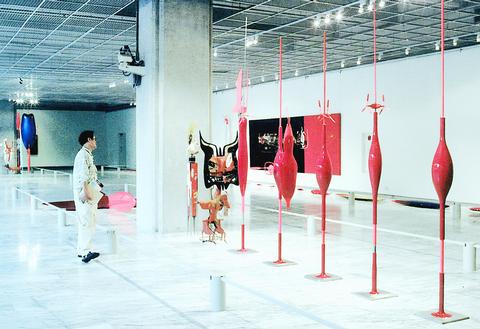
PHOTO COURTESY OF TFAM
But if all that were true, and if the contemporary Hwang was actually just another anachronistic modernist, then his work would be boring. The thing is, however, that it's not.
Certainly, Hwang is a sculptor in the modernist tradition. He is a maker of objects and assemblages based on a language of forms, colors and abstraction. He is also much indebted to modern masters like Constantin Brancusi, Alexander Calder and George Ricky, all of whom explored abstraction and motion through sculpture.
But Hwang has not stopped with their modes of signifying ideas, and laudably so. There's something unmistakably contemporary about his sculptures from their formal characteristics to the ideas they communicate.
To begin with Hwang's formal devices: his palette is full of hot pinks, lipstick reds and hyper-glossy hues that might as well have come straight off sports cars. (Most of the sculptures are, in fact, made of metal coated with new car-quality paint jobs. Several also involve kinetic elements, like rotors and hanging parts). His dictionary of forms -- aquadynamic and aerodynamic, resembling yacht keels, airplane propellers, fan blades and even stylized, plastic-pressed sea creatures -- is organic and irregular and seems to have nothing to do with the high moderns' reverence for a pure geometry.
The themes Hwang's sculptures address also leave modernism behind. Based in the unnatural, yet now universally recognizable, visual language of a man-made world -- covering everything from jet planes to music videos to plastic dresses -- his work alludes to ideas (among them: racy, sexy and sleek) straight out of the mass market consciousness.
Many of his pieces could stand as sculptural representations of the essences of the things underlying our universe of cultural gloss. In other words, if a Porsche or a fashion magazine or a 30 second TV ad for dishwasher detergent can be converted into a three dimensional piece of art, Hwang has done it.
But not, however, in every piece in the show. Some of the older works -- a few wooden sculptures, assemblages of found objects and one painting -- seem a little stale, dull and not so brilliant in their limited pursuit of the old modernist ideals. There are only a few such pieces, though, and if they do not create much resonance with what's going on in the present day, they do shed some light on the development process leading up to Hwang's newer work, a body which is quite alluring indeed.
Urban and Ambiguity: Lu Pei-lin
There's something kind of silly about a big room full of partially corroded, metal-sided teepees that keep licking their lips at you through pink furry mouths. There's also something slightly, just slightly, unnerving about it.
The exhibition, entitled Urban and Ambiguity (
At about chest height in each of the big conical tubes is a thin horizontal slot about a meter wide. The opening is lined, in a jarring juxtaposition to the weathered metal, with Day-Glo pink fur. Revolving at different speeds across these shiny, furry slots are portions of discs made out of flesh-toned latex or plastic. Each revolution makes the generic urban monuments look like they're licking their lips, perhaps hungrily or salaciously or threateningly, at you, the viewer.
This constant lip smacking seems designed to raise questions about how organic components and the ways they end up fitting into larger industrial schemes. For example: are these revolving pink discs just fleshy cogs in some great mechanical system? Or do these inhuman tongues, in their highly limited way, have something to communicate?
An individual could easily ask similar questions about his or her station in the urban continuum, such as: as far as I am concerned, to what extent do other humans I encounter in this megalopolis merely serve functions? And, even though I perceive my own freedom in the midst of minions who are highly constrained by their systems, do others perceive me in the same way?
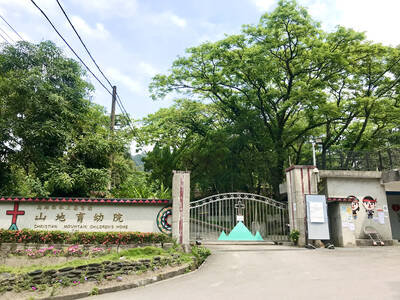
May 18 to May 24 Pastor Yang Hsu’s (楊煦) congregation was shocked upon seeing the land he chose to build his orphanage. It was surrounded by mountains on three sides, and the only way to access it was to cross a river by foot. The soil was poor due to runoff, and large rocks strewn across the plot prevented much from growing. In addition, there was no running water or electricity. But it was all Yang could afford. He and his Indigenous Atayal wife Lin Feng-ying (林鳳英) had already been caring for 24 orphans in their home, and they were in
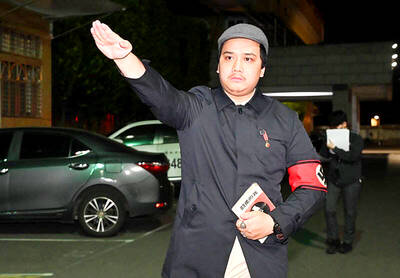
On May 2, Chinese Nationalist Party (KMT) Chairman Eric Chu (朱立倫), at a meeting in support of Taipei city councilors at party headquarters, compared President William Lai (賴清德) to Hitler. Chu claimed that unlike any other democracy worldwide in history, no other leader was rooting out opposing parties like Lai and the Democratic Progressive Party (DPP). That his statements are wildly inaccurate was not the point. It was a rallying cry, not a history lesson. This was intentional to provoke the international diplomatic community into a response, which was promptly provided. Both the German and Israeli offices issued statements on Facebook
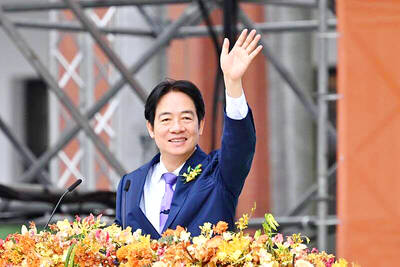
President William Lai (賴清德) yesterday delivered an address marking the first anniversary of his presidency. In the speech, Lai affirmed Taiwan’s global role in technology, trade and security. He announced economic and national security initiatives, and emphasized democratic values and cross-party cooperation. The following is the full text of his speech: Yesterday, outside of Beida Elementary School in New Taipei City’s Sanxia District (三峽), there was a major traffic accident that, sadly, claimed several lives and resulted in multiple injuries. The Executive Yuan immediately formed a task force, and last night I personally visited the victims in hospital. Central government agencies and the
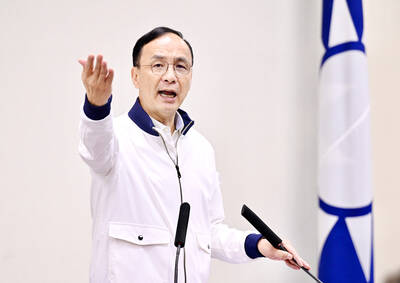
Australia’s ABC last week published a piece on the recall campaign. The article emphasized the divisions in Taiwanese society and blamed the recall for worsening them. It quotes a supporter of the Taiwan People’s Party (TPP) as saying “I’m 43 years old, born and raised here, and I’ve never seen the country this divided in my entire life.” Apparently, as an adult, she slept through the post-election violence in 2000 and 2004 by the Chinese Nationalist Party (KMT), the veiled coup threats by the military when Chen Shui-bian (陳水扁) became president, the 2006 Red Shirt protests against him ginned up by